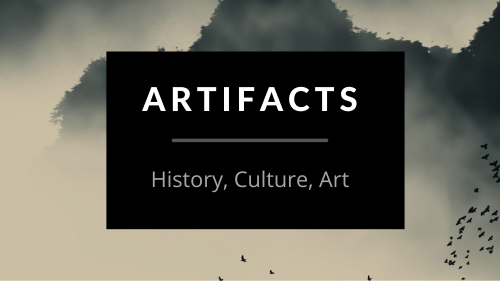The Musicians by Caravaggio: The Joyful Toil of Artistic Creation
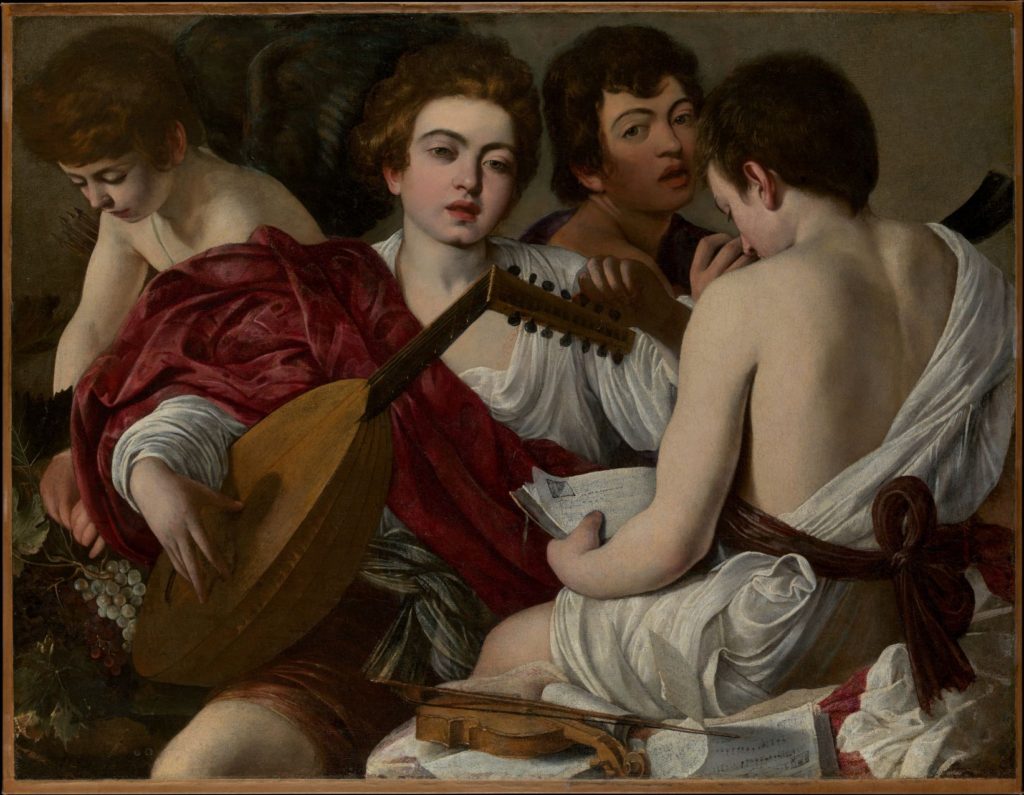
Creative pursuits are by their nature a journey. The final product the result of experimentation, practice, skill, and resolve. Intermingled with this is a range of emotions, culminating (if one is lucky enough) in a sense of joy. But to get to that stage is a long process, made up of lengthy periods alone with one’s work. Few were more familiar with this than the late 16th/early 17th century painter Michelango Merisi da Caravaggio, who memorialized this process in his painting, The Musicians. The work depicts a group of musicians in mid-rehearsal. Nothing about what they are doing appears extraordinary (at least on the surface). But Caravaggio, in his understated way, elevates it into a celebration of both the quiet toil that goes into a work of art and the nobility inherent in such pursuits. It is these mundane moments, he seems to be saying, that define an artist.
Table of contents
Style: Painting from Nature
Caravaggio’s The Musicians is among his best known earlier works. Though it was held in a private collection, many famous artists of Caravaggio’s day found opportunities to see it. As with Caravaggio’s other art, the “naturalism” of the piece is what first jumped out at many. Naturalism, in this context, simply means painting objects and scenes from real life, often with the aid of a model. Caravaggio’s naturalism was controversial with many of his contemporaries. The prevailing view in Rome at the turn of the 16th century was that it was the job of the artist to depict figures and scenes in an idealized fashion, carefully arranged to achieve a certain aesthetically pleasing effect. In this climate, Caravaggio’s naturalistic style of painting was regarded as evidence of a fatal lack of imagination. Yes, he knew his way around a brush, his critics would concede, but his work lacked the creative genius of a true master.

In the case of The Musicians, two elements of the painting would have struck early observers as “naturalistic.” The first is the mundanity of the scene itself – an ordinary rehearsal. This broke with the general convention of depicting musicians either in concert or in pastoral settings (see the history section below for more on this).
The second is Caravaggio’s decision to paint the figures of the musicians using a model. In Caravaggio’s time, artists generally only used models in simple compositions (such as portraiture) or in preparatory drawings for more complex works. This latter practice allowed the artist to better visualize their figures as they worked through the details of a composition. However, when it came time to actually set paint to canvas, the models were often dispensed with. In the completed work, only a shadow of the model remained – the original figure having been transformed (some would say distorted) into a romanticized and idyllic form.
Caravaggio was not interested in these artificial figures. “Nature” was his master, or so he would claim years later. Painting directly from a model gave Caravaggio’s figures a more authentic feel, bringing a level of vitality to his paintings that was absent in the work of his contemporaries. So strange was this style of painting that some of Cavaggio’s critics suspected he was unable to paint without a model present. One of his early biographers wrote, “the moment the model was taken from him, his hand and his mind became empty.” This critic could not imagine that someone might prefer to paint real people – made of flesh and blood – to the highly stylized figures then in fashion.
There were certain elements, however, that Caravaggio did not paint true to life, chief among them the distorted space in which the musicians are pictured. As art historian Keith Christiansen points out, the musicians are impossibly close to each other – with the singer’s knee seeming to project into the lute player’s groin. This may have been an artifact of Caravaggio’s use of the same model for multiple figures. It also highlights the challenges of painting without first making preparatory drawings.
This discordant aspect of the painting aside, Caravaggio does achieve a believable sense of compression in the image. Like in an ancient bas-relief, the activity of the musicians seems confined to a tight plane within the picture. The contrasting positions of the lute player (who looks forward) and the singer (who sits with his back to the viewer) add to this. Overall, it gives the impression that the musicians are rehearsing in a modest, enclosed studio – probably like the one Caravaggio must have painted this picture in.
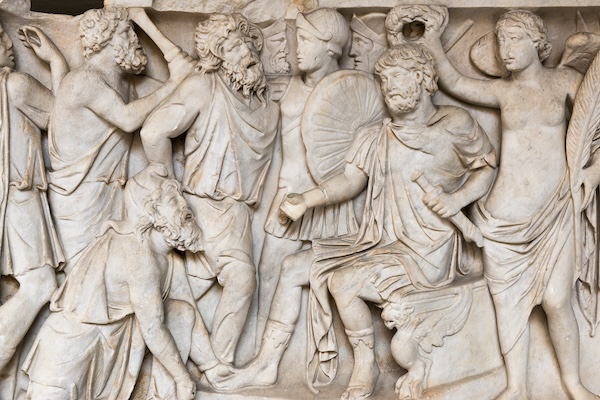
History: Revolutions in Music and Painting
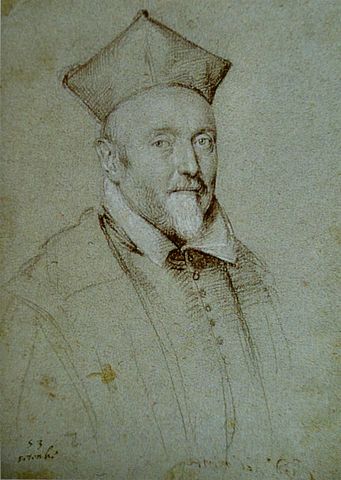
Caravaggio painted The Musicians in 1597, not long after obtaining the patronage of Cardinal Francesco Maria del Monte. Living with del Monte, it is not difficult to understand why Caravaggio might have felt inspired to create paintings on musical subjects. In the music circles of Rome, del Monte was king. He served as Protector of the Sistine Choir and was tasked by Pope Clement VIII with a far-reaching reform of liturgical music. Del Monte even turned his home, Palazzo Madama, into a veritable musical institution, where famed singers were provided room, board, and training.
The musical atmosphere that Caravaggio would have encountered while living with del Monte is perhaps best captured in an account of an evening in 1602 from the composer Emilio de’ Cavelieri – himself a close friend of del Monte’s. That evening, del Monte invited a small group of friends to join him at his vineyard. This group included the famed soprano Vittoria Archilei, who at the other guests urging, gave an impromptu performance. Joined only by the instrumental accompaniment of her husband, Archilei’s solo performance that evening stunned all in attendance. A cardinal who witnessed the performance said afterward that he felt shame for not weeping.
Art historian and Caravaggio biographer Andrew Graham-Dixon suggests that the emotional power of the performance was likely in part due to its shear novelty. Up until this point, medieval polyphony had been the dominant form of music in Rome. In this style, individual voices are lost amidst the singing of the choir, creating, in Graham-Dixon’s words, an “otherworldly sound.” Archilei’s solo performance was a demonstration of the emotional potential of an individual voice. A more focused melody allowed the audience to connect with the singer and made the poetry in the lyrics more intelligible. Hearing this new style of music for the first time, sung by a skilled soprano like Archilei, was overpowering.
Inspired by the revolution in the field of music occurring around him, Caravaggio sought to introduce his own innovations in The Musicians. Most notable is his unorthodox approach to the established genre known as “concert painting.” The roots of this genre stretch back to the Venetian Renaissance, which produced the most famous work in this tradition – the Pastoral Concert (1509), generally ascribed to Titian.
This painting depicts a nobleman in the countryside strumming a lute while conversing with a shepherd. Two nude women, often identified as nymphs, appear nearby. In the background is a bright landscape stretching far into the distance. The exact meaning of the piece is debated, but is generally regarded as an allegory for poetry, music, and love. In The Musicians, Caravaggio keeps with the tradition of allegory, but transports his subjects from the bright Italian countryside to a cramped rehearsal studio. In so doing, Caravaggio suggests that the magic alluded to by Titian and other masters is not to be found in some mythological Arcadia, but rather in quiet moments in the artist’s studio.
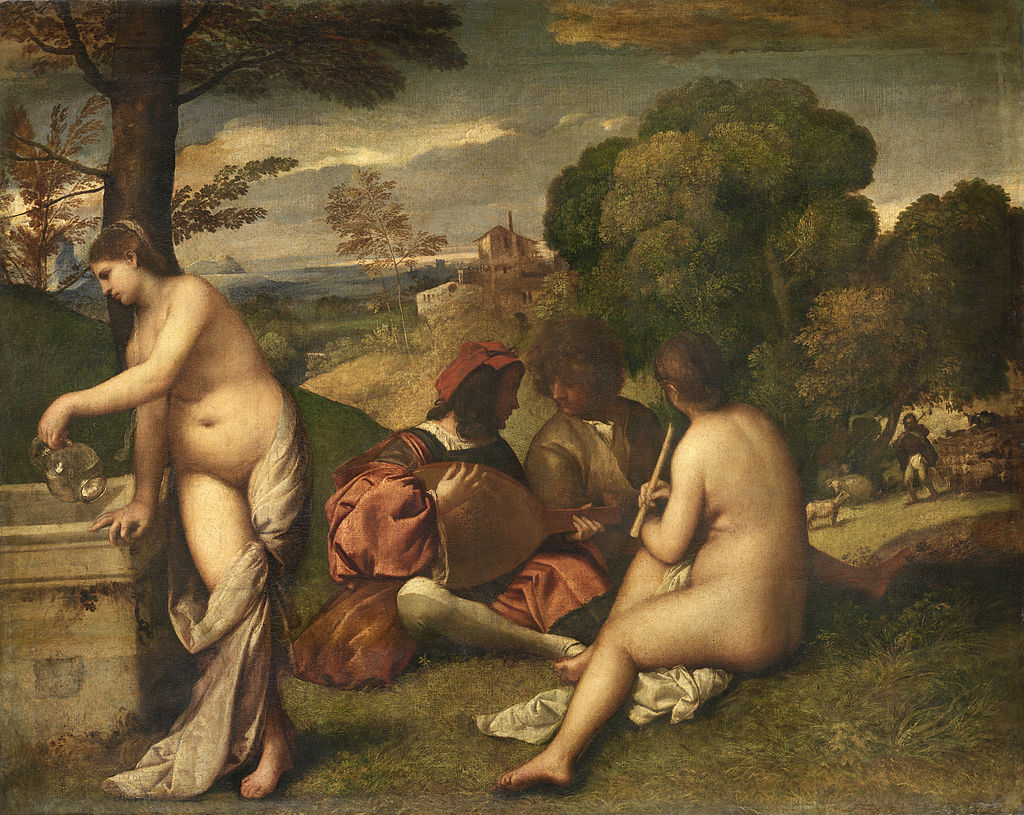
Symbolism and Themes: The Generation of Art
The most important theme in Caravaggio’s The Musicians is suggested by the moment it depicts – a rehearsal. Here we see three young men hard at work – the singer studying a sheet of music; the lute player staring off into space, seemingly lost in the creation of a melody; and the cornetto player, who looks up engaging the viewer. By depicting this moment, Caravaggio puts the focus on the creation of music itself – an artistic process which Caravaggio himself identified with. Caravaggio even includes his self-portrait in the guise of the cornetto player, suggesting a link between his own work and that of the musicians. Lest there be any doubt that the musicians are engaged in a weighty undertaking, Caravaggio garbs the group in classical Roman attire. This elevates the scene and suggests an inherent nobility in the work of artists, be they musicians or painters.
A second theme woven into the piece is that of love. This is suggested by the presence of Cupid and in the dreamy expressions of the musicians, most notably the lute player. The connection between music and love was a staple of the concert painting genre, and one Caravaggio chose to continue.
From Rome to Egypt – Music in the Art of Caravaggio
The influence of del Monte’s musical milieu together with his own identification with the artistic toil of musicians appears to have been a source of ongoing inspiration for Caravaggio. Shortly after finishing The Musicians, Caravaggio painted The Lute Player for del Monte’s friend (and neighbor), Vincenzo Giustiniani – who shared many of del Monte’s artistic tastes. In this painting, a young man (often confused for a woman) looks wistfully into space as he strums a lute. It has been suggested that the famed castrato Pedro Montoya himself was the model for this painting, particularly as the lack of facial hair and plump cheeks are suggestive of the hormonal changes associated with castration. An assortment of objects lie around the lute player – a carafe of flowers, a violin, a pile of fruit, and a book of music. The book of music is open to a love song. The pages of music in The Musicians are now illegible or replaced with modern recreations, but if the presence of cupid is any guide, they likely once depicted the notes of a love song as well.

Not long after painting The Lute Player, Caravaggio painted Rest on the Flight Into Egypt. This painting depicts the Holy Family’s escape from Bethlehem in advance of Herod’s massacre of the innocents. Here too, music is placed at the center. Joseph, who appears haggard and tired, holds open a book of music for an angel, who serenades the family with a violin. Sitting apart is the Virgin Mary, who cradles the infant Jesus. She appears overwhelmed by weariness, closing her eyes as her child rests against her breast.
Caravaggio’s decision to make music a central focus of the scene was a marked departure from other depictions of the holy family’s flight into Egypt – especially given that no such scene is described in the gospels. Perhaps it is Caravaggio’s way of putting art on par with the other miracles performed by the infant Jesus on the flight into Egypt. These miracles included ordering the trees to bend down so Joseph could pick fruit from them and causing water to gush up from the ground to quench their thirst. By bringing music into the story, Caravaggio is putting a need for art on par with food and water.

Caravaggio’s The Musicians As a Celebration of Art
With Rest on the Flight into Egypt, Caravaggio has brought things full circle. Here, music – and by extension all art – is elevated to the level of divine sustenance. This is what art at its best could be, Caravaggio must have imagined. But he also understood that the process of creating art began not in the gallery of a nobleman or at the altar of one of Rome’s great churches. Artistic triumph was fought for and achieved in a studio, alone with one’s work. If his self-portrait is any guide, it was a process Caravaggio reveled in. In The Musicians, Caravaggio stares at the viewer, his mouth partially open – as if about to call out, “you found me.” Here, at work creating art, Caravaggio finally felt at home.
Sources/Further Reading on The Musicians by Caravaggio
- For more information on Caravaggio, see this post on the artist’s life and most famous paintings.
- For more on naturalism in the art of Caravaggio, see this post on his only known still life – Basket of Fruit.
- For more on Caravaggio’s naturalistic depiction of religious themes, see this post on his Adoration of The Shepherds.
- Check out the Met’s page on The Musicians, here. Scroll down to “Catalogue Entry” for further information about this piece.
- Christiansen, Keith. Caravaggio and “L’esempio davanti del naturale.” The Art Bulletin Vol. 68, No. 3 (Sep., 1986), pp. 421-445
- Christiansen, Keith. “Going for Baroque: Bringing 17th-Century Masters to the Met” The Metropolitan Museum of Art Bulletin , Winter, 2005, New Series, Vol. 62, No. 3, pp. 3-48
- Camiz, Franca Trinchieri. “Music and Painting in Cardinal del Monte’s Household.” Metropolitan Museum Journal, 1991, Vol. 26 (1991), pp. 213-226
- Gregory, Sharon. Caravaggio and Vasari’s “Lives.” Artibus et Historiae , 2011, Vol. 32, No. 64, Special issue on the quincentennial of Giorgio Vasari’s birth (1511-2011) (2011), pp. 167-191
- Mahon, Denis and Rousseau, Theodore Jr. “On Some Aspects of Caravaggio and His Times.” The Metropolitan Museum of Art Bulletin, Oct., 1953, New Series, Vol. 12, No. 2 (Oct., 1953), pp. 33-45
- Graham-Dixon, Andrew. “Caravaggio: A Life Sacred and Profane.” Allen Lane and Penguin Books. London. 2010 – A beautiful and very readable biography of Caravaggio. I highly recommend it.

